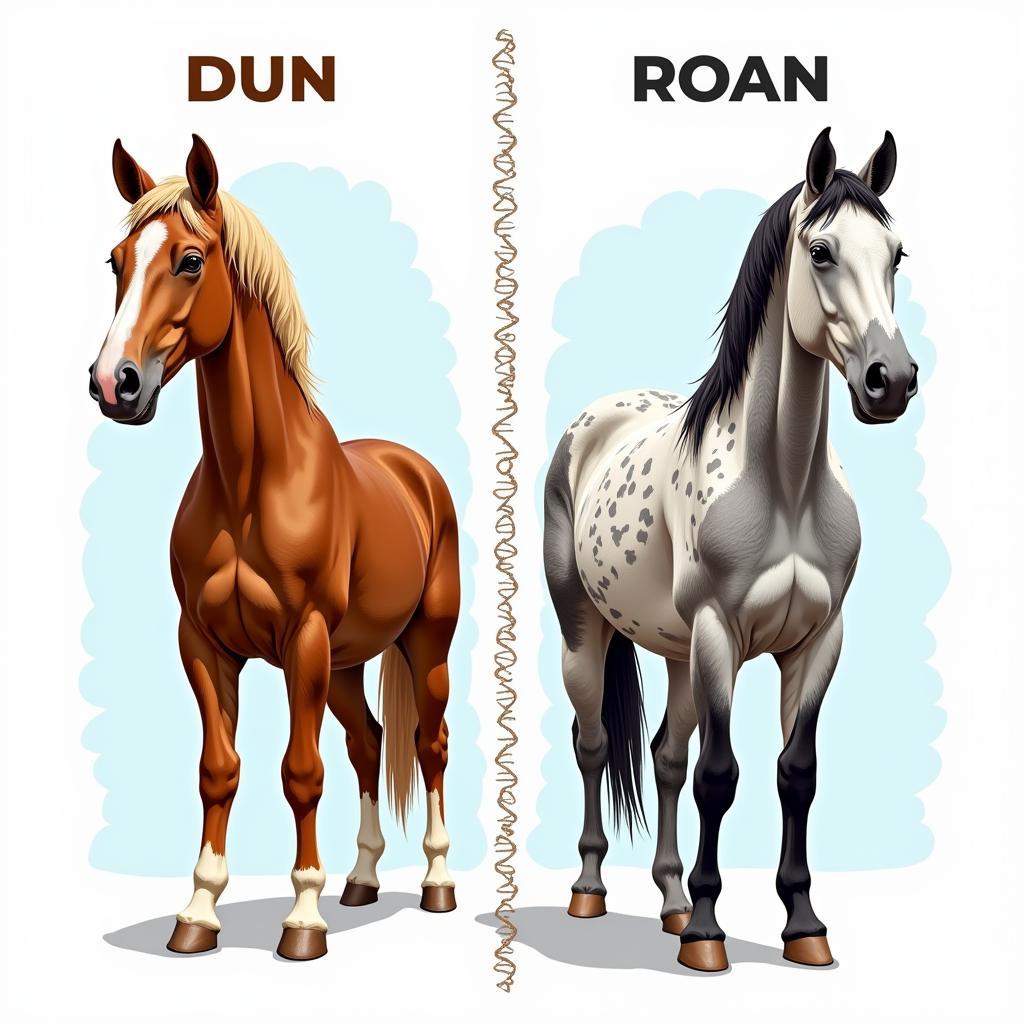Horse Hair Color is a fascinating subject, revealing a surprising complexity beyond the basic browns and blacks we often see. From shimmering chestnuts to striking pintos, the diverse palette of equine coats is a testament to genetics, breed, and even environmental factors. This article delves deep into the science and beauty of horse hair color, exploring the genetic basis, the influence of breed, and the various patterns and shades that adorn these magnificent animals.
Understanding horse hair color goes beyond simple aesthetics. It can provide insights into a horse’s ancestry, potential health predispositions, and even influence its perceived value. Whether you’re a seasoned equestrian, a curious nature lover, or simply captivated by the beauty of horses, join us as we unravel the mysteries behind their diverse coat colors.
The Genetics Behind Horse Hair Color
At the heart of horse hair color lies a complex interplay of genes. These genes dictate the production and distribution of melanin, the pigment responsible for color in hair and skin. Two primary types of melanin influence horse coat color: eumelanin (black/brown pigment) and pheomelanin (red/yellow pigment). The combination and expression of these pigments create the vast array of colors we observe. Base coat colors, such as black, bay, and chestnut, are determined by the interaction of several key genes.
Understanding the Role of Extension and Agouti Genes
Two of the most influential genes in horse coat color are the extension (E) and agouti (A) genes. The extension gene controls the production of eumelanin. The dominant E allele allows for black pigment production, while the recessive e allele restricts pigment to red/yellow pheomelanin, resulting in a chestnut base coat. The agouti gene modifies the distribution of black pigment, restricting it to the points (mane, tail, and lower legs) in bay horses. Horses with two recessive a alleles have black pigment distributed over the entire body, resulting in a black coat.
Breed Influences on Horse Hair Color
Certain breeds are predisposed to specific coat colors due to selective breeding practices. For instance, Friesian horses are almost exclusively black, while Haflingers are known for their distinctive chestnut coat with a flaxen mane and tail. Appaloosas, on the other hand, showcase a wide array of spotted patterns. This breed-specific association with particular colors contributes to the rich tapestry of equine coat diversity.
Exploring the Colorful World of Appaloosas
Appaloosas are renowned for their unique and eye-catching coat patterns. These patterns, including leopard, blanket, and snowflake, are a result of the leopard complex (Lp) gene. The Lp gene modifies the distribution of pigment cells, creating areas of white or depigmented skin and hair. This genetic quirk results in the striking and diverse coat patterns that make Appaloosas so distinctive.
Common Horse Hair Color Patterns and Shades
Beyond the base coat colors, a variety of patterns and shades further enhance the diversity of horse hair color. Dun, roan, gray, and paint are just a few examples of these fascinating variations. Each pattern has a unique genetic basis and contributes to the overall beauty and individuality of the horse. Understanding these patterns can help in identifying breeds and appreciating the intricate genetics at play.
The Subtle Beauty of Dun and Roan
Dun horses exhibit a primitive marking pattern characterized by a dorsal stripe, leg barring, and sometimes shoulder stripes. The dun dilution gene lightens the base coat color while leaving the primitive markings darker. Roan, on the other hand, is characterized by a mixture of white and colored hairs throughout the body, giving the coat a speckled appearance. The roan gene doesn’t affect the mane, tail, or lower legs, which typically retain the base coat color. These subtle yet distinctive patterns add another layer of complexity to the world of horse hair color.
 Comparing Dun and Roan Horse Coat Colors
Comparing Dun and Roan Horse Coat Colors
Conclusion
Horse hair color is a captivating subject, reflecting the intricate interplay of genetics, breed, and environment. From the basic black and brown to the vibrant patterns of Appaloosas, the diversity of equine coat colors is truly remarkable. Understanding the genetics and influences behind these colors enhances our appreciation for the beauty and complexity of these magnificent animals. So, the next time you admire a horse’s coat, remember the fascinating genetic story it tells.
FAQs
- What is the most common horse hair color?
Chestnut is one of the most common horse hair colors. - Can a horse’s coat color change over time?
Yes, some horses, particularly grays, can experience a gradual lightening of their coat color over time. - Are certain coat colors linked to specific health issues?
Some coat colors, particularly white, can be associated with increased sensitivity to sunlight and a higher risk of skin cancer. - How are horse coat colors inherited?
Horse coat colors are inherited through a complex interaction of genes passed down from both parents. - What is the difference between a palomino and a buckskin horse?
Both are dilutions of a base coat, but a palomino is a dilution of chestnut, while a buckskin is a dilution of bay. - What is the rarest horse hair color?
True white is considered one of the rarest horse hair colors. - How can I learn more about horse coat color genetics?
Numerous online resources and books provide in-depth information about equine coat color genetics.
You might also be interested in reading about household objects that start with v.
For any assistance, contact us at Phone Number: 0902476650, Email: [email protected] or visit us at 139 Đ. Võ Văn Kiệt, Hoà Long, Bà Rịa, Bà Rịa – Vũng Tàu, Việt Nam. We have a 24/7 customer support team.





